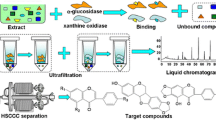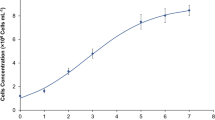Abstract
Pinoresinol diglucoside (PDG) is the important antihypertensive compound in Eucommia ulmoides Oliv., a traditional Chinese herb medicine. The research objective was to certify the possibility of producing PDG through fermentation. PDG-producing endophytic fungi were isolated from E. ulmoides Oliv., and the highest PDG-yielding (11.65 mg/L) isolate, XP-8, was identified as Phomopsis sp. according to the morphological characteristics and the phylogenetic tree constructed on the basis of the gene sequence in the internal transcribed spacers district. The microbial PDG was isolated by using S-8 resin and purified to a purity of 98.7% using preparative high-performance liquid chromatography (HPLC). Information obtained from the UV spectrum (277 and 227 nm, in water solution), infra-red spectrum (3,428; 2,930; 2,877; 1,637; 1,600; and 1,513; 1,460; 1,421; 1,269; 1,223; 1,075; 658 cm−1, in powder), molecular weight (682 Da, measured using HPLC-electrospray ionization mass spectrometry (ESI/MS) and tandem mass spectrometry), and nuclear magnetic resonance analysis show the microbial PDG is (+)-1-pinoresinol 4,4′-di-O-β-d-glucopyranoside, same as the plant-derived PDG. The microbial PDG is stable in pH range from 3 to 11 but less stable at temperature higher than 90 °C and in light exposure. During the fermentation, PDG production outside cells starts at the later stage of cell growth when the residual sugar in the medium was low. The study reveals the possibility for production of PDG by fermentation.






Similar content being viewed by others
References
Bouxin F, Baumberger S, Pollet B, Haudrechy A, Renault JH, Dole P (2010) Acidolysis of a lignin model: investigation of heterogeneous catalysis using Montmorillonite clay. Bioresour Technol 101:736–744
Brayford D (1990) Variation in Phomopsis isolates from Ulmus species in the British-Isles and Italy. Mycol Res 94:691–697
Chang CQ, Xi PG, Xiang MM, Jiang ZD, Chi PK (2005) New species of Phomopsis on woody plants in Hunan Province. Mycosystema 24:145–154
Charles JS, Madison W (1978) Glycosides of 2,6-bis(hydroxyl-phenyl)-3,7-dioxabicyclo[3,3,0] octane. US Patent 4:103–106
Charles JS, Ravikumt PR, Huang FC (1976) Isolation and synthesis of pinoresinol diglucoside, a major antihypertensive principle of Tu-Chung (Eucommia ulmoides Oliv.). J Am Chem Soc 98:5412–5413
Chen HJ, Tseng DH, Huang SL (2005) Biodegradation of octylphenol polyethoxylate surfactant Triton X-100 by selected microorganisms. Bioresour Technol 96:1483–1491
Chi PK, Jiang ZD, Xiang MM (2007) Flora fungorum sinicorum vol. 34 Phomopsis. Science Press, Beijing, pp 1–185, in Chinese
Dadwal VS, Verma RK, Jamaluddin (2003) A new species of Phomopsis causing phyllode spot and top dying in Acacia mangium. J Mycol Pl Pathol 33:42–44
Deyama T, Nishibe S, Nakazawa Y (2001) Constituents and pharmacological effects of Eucommia and Siberian ginseng. Acta Pharmacol Sin 22:1057–1070
Di LQ, Liu SJ, Zhao XL (2007) Research on the quality changes in pre- and post-processed pieces of Eucommia ulmoides. Zhong Yao Cai 5:525–529
Drolc A, Vrtovsek J (2010) Nitrate and nitrite nitrogen determination in waste water using on-line UV spectrometric method. Bioresour Technol 101:4228–4233
El HH, Bailly JR, Winterton P, Merlina G, Revel JC, Hafidi M (2008) Chemical and spectroscopic analysis of olive mill waste water during a biological treatment. Bioresour Technol 99:4958–4965
Feng SM, Ni SF, Sun WJ (2007) Preparative isolation and purification of the lignan pinoresinol diglucoside and liriodendrin from the bark of Eucommia ulmoides Oliv. by high speed countercurrent chromatography. J Liq Chromatogr Related Technol 30:135–145
Larran S, Perello A, Simon MR, Moreno V (2002) Isolation and analysis of endophytic microorganisms in wheat (Triticum aestivum L.) leaves. World J Microb Biot 18:683–686
Luo LF, Wu WH, Zhou YJ, Yan J, Yang GP, Ouyang DS (2010) Antihypertensive effect of Eucommia ulmoides Oliv. extracts in spontaneously hypertensive rats. J Ethnopharmac 129:238–243
Murali TS, Suryanarayanan TS, Geeta R (2006) Endophytic Phomopsis species: host range and implications for diversity estimates. Can J Microbiol 52:673–680
Nadji H, Diouf PN, Benaboura A, Bedard Y, Riedl B, Stevanovic T (2009) Comparative study of lignins isolated from Alfa grass (Stipa tenacissima L.). Bioresour Technol 100:3585–3592
Naik BS, Shashikala J, Krishnamurthy YL (2009) Study on the diversity of endophytic communities from rice (Oryza sativa L.) and their antagonistic activities in vitro. Microbiol Res 164:290–296
Qi X, Zhang S (1998) A reversed-phase high performance liquid chromatographic method for the determination of pinoresinol diglucopyranoside in Eucommia ulmoides Oliv. Se Pu 16:161–163
Raman B, Sharma BA, Ghugare PD, Karmuse PP, Kumar A (2009) Semi-preparative isolation and structural elucidation of an impurity in citalopram by LC/MS/MS. J Pharmaceut Biomed 50:377–383
Rukachaisirikul V, Sommart U, Phongpaichit S, Sakayaroj J, Kirtikara K (2008) Metabolites from the endophytic fungus Phomopsis sp. PSU-D15. Phytoche 69:783–787
Schulz B, Boyle C (2005) The endophytic continuum. Mycol Res 6:661–686
Song JZ, Cheung LM, Liu X, Qiao CF, Zhou Y, Li SL, Chen SL, Xu HX (2010) Development and validation of an ultra high-performance liquid chromatographic method for the determination of a diastereomeric impurity in (+)-pinoresinol diglucoside chemical reference substance. J Sep Sci 13:1909–1915
Stierle A, Strobel G, Stierle D (1993) Taxol and taxane production by Taxomyces andreanae, an endophytic fungus of Pacific yew. Sci 260:214–216
Strobel G, Daisy B (2003) Bioprospecting for microbial endophytes and their natural products. Microbiol Mol Biol R 5:535–544
Sun YX, Liang HT, Zhang XT, Tong HB, Liu JC (2009) Structural elucidation and immunological activity of a polysaccharide from the fruiting body of Armillaria mellea. Bioresour Technol 100:1860–1863
Suryanarayanan TS, Thirunavukkarasu N, Govindarajulu MB, Sasse F, Jansen R, Murali TS (2009) Fungal endophytes and bioprospecting. Fungal Biol Rev 23:9–19
Thompson JD, Gibson TJ, Plewniak F, Higgins DG (1997) Clustal X windows interface: flexible strategies for multiple sequence alignment aided by quality analysis tools. Nucleic Acids Res 24:4876–4882
Uecker FA (1988) A world list of Phomopsis names with notes on nomenclature, morphology and biology. Mycol Mem 13:1–231
Xiao JB, Wei XL, Wang YF (2009) Extraction and determination of major hypotensive compounds in bark of Eucommia ulmoides Oliv. Arch Biol Sci 4:811–817
Yao LN, Su YF, Yin ZY, Qin N, Li TX, Si CL, Liu EW, Gao XM (2010) A new phenolic glucoside and flavonoids from the bark of Eucommia ulmoides Oliv. Holzforschung 5:571–575
Yuan GQ, Wei JG, Li QQ, Lai CY (2008) A new species of Phomopsis causing brown spot of Ziziphus mauritiana. Mycosystema 27:631–633
Zhou XW, Zhu HF, Liu L, Lin J, Tang KX (2010) A review: recent advances and future prospects of taxol-producing endophytic fungi. Appl Microbiol Biot 86:1707–1717
Acknowledgment
This work was supported by the Special Fund for Agro-scientific Research in the Public Interest (201003021) and the Key Technologies R & D Program of Shaanxi Province (2008 K02-09) of China. Work devoted on revision and English language polishing done by Dr. Zhongli Pan, a Research Engineer USDA-ARS West Regional Research Center and a Professor in UC Davis, is also greatly appreciated.
Author information
Authors and Affiliations
Corresponding author
Rights and permissions
About this article
Cite this article
Shi, J., Liu, C., Liu, L. et al. Structure identification and fermentation characteristics of pinoresinol diglucoside produced by Phomopsis sp. isolated from Eucommia ulmoides Oliv. Appl Microbiol Biotechnol 93, 1475–1483 (2012). https://doi.org/10.1007/s00253-011-3613-8
Received:
Revised:
Accepted:
Published:
Issue Date:
DOI: https://doi.org/10.1007/s00253-011-3613-8




